In developing this website I have become increasingly aware that the diverse disciplinary and methodological approaches people use to write about place revolve around just a few interpretations of what place is, and a slightly larger but mostly implicit set of reasons about why place is worth studying. This post is an initial attempt to identify what I think are the most significant of those interpretations and reasons. I have no doubt it is possible to come up with different categories (and would be grateful for any suggestions you might have) but the ones I note here have provided a useful basis to organize my thinking and I hope they may have some value for others. I think it informative that the illustrations, which I chose after I had derived these simple classification, suggest that these interpretations also seem apply to everyday ways the concept of place is used.
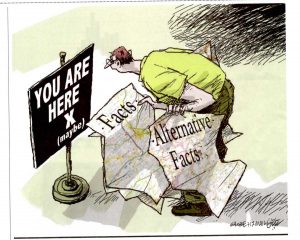
From the Victoria Times Colonist, February 2017
It is important to note, especially in the context of the current post-truth world, that there seems to be an implicit but common conviction that a clear understanding of our experiences of place is about as close as we can get by ourselves to a confident sense of what constitutes reality. Hence the title of this post. Place experience offers one basis for the development of independent thinking that can challenge and resist borrowed opinion and facile generalization.
A brief background
The importance of place in human experience is revealed in the fact that it is such a widely used word in many languages, one used in a wide range of different meanings and contexts. As a subject of intellectual and academic inquiry it has a long but mostly marginal history. However, since about 1970, and especially since 1990, academic studies of the idea and experience of place have surged. It has been discussed in various ways in thousands of articles and books in social sciences (geography, psychology, anthropology, sociology, gender studies), in humanities (philosophy, theology, fine art, literature and cultural studies), in some sciences (neuroscience, and ecology) and in architecture, landscape architecture and business.
Four Basic Interpretations of Place
In spite of the newness, range and sheer number of academic discussions about aspects of place, I think there are just four main types of interpretations (or perhaps assumptions) about what constitutes place. Aspects of these are often combined, but most authors writing about place gives clear preference to just one of them, and regard the others as secondary.
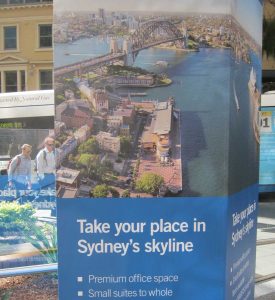 • Place as primarily a material attribute of the world. A place is some thing somewhere – a room, a building, a neighbourhood, a park, a city, a mountain, It is a fragment of geography. This interpretation prevails in architecture, urban planning, traditional regional geography, ecology, and placemaking. This material idea of place is conveyed in this advertisement for a proposed development in Sydney in 2014.
• Place as primarily a material attribute of the world. A place is some thing somewhere – a room, a building, a neighbourhood, a park, a city, a mountain, It is a fragment of geography. This interpretation prevails in architecture, urban planning, traditional regional geography, ecology, and placemaking. This material idea of place is conveyed in this advertisement for a proposed development in Sydney in 2014.
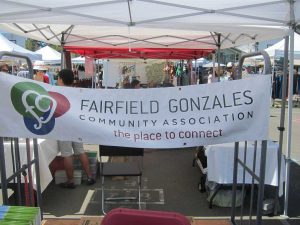 • Place as primarily a way of being attached to or connecting with the world and with others. These connections might be through habitual actions and familiarity, emotional engagements, or participation in local communities. At a personal scale these connections are regarded as extensions of the body; at a social scale they are variously manifest in place names that provide a means of communicating shared place identities and in the myriad ways in which we participate in communities . This interpretation prevails in environmental psychology, sociology, anthropology, some philosophical studies, and theology. This banner for Fairfield Gonzales Community Association in Victoria B.C. explicitly captures the idea of place as connection,
• Place as primarily a way of being attached to or connecting with the world and with others. These connections might be through habitual actions and familiarity, emotional engagements, or participation in local communities. At a personal scale these connections are regarded as extensions of the body; at a social scale they are variously manifest in place names that provide a means of communicating shared place identities and in the myriad ways in which we participate in communities . This interpretation prevails in environmental psychology, sociology, anthropology, some philosophical studies, and theology. This banner for Fairfield Gonzales Community Association in Victoria B.C. explicitly captures the idea of place as connection,
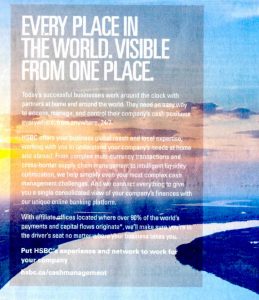 • Place as primarily a socio-economic construct. Places are distinctive local nodes in networks of economic relationships that operate at regional and global scales. This economic interpretation of place prevails in the work of political-economic geographers who are critical of neo-liberalism. Paradoxically, it is also the foundation for business studies that advocate place branding and other strategies that are intended to generate a competitive advantage for particular places. This illustration is an advertisement for HSBC from August 2015. The text reads, in part: “Today’s successful businesses work around the clock with partners at home and around the world…HSBC offers your business global reach and local expertise.”
• Place as primarily a socio-economic construct. Places are distinctive local nodes in networks of economic relationships that operate at regional and global scales. This economic interpretation of place prevails in the work of political-economic geographers who are critical of neo-liberalism. Paradoxically, it is also the foundation for business studies that advocate place branding and other strategies that are intended to generate a competitive advantage for particular places. This illustration is an advertisement for HSBC from August 2015. The text reads, in part: “Today’s successful businesses work around the clock with partners at home and around the world…HSBC offers your business global reach and local expertise.”
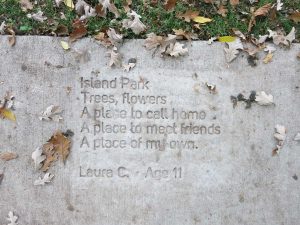 • Place as primarily a lens through which to interpret experiences of the world. This is associated with the phenomenological view that place is the first of all things because whatever we do has to be done in places, and that places are territories that gather meaning. This interpretation prevails among philosophers and humanistic geographers aiming to disclose the sort of subtle and profound character of place experience that is suggested in this poem by Laura C. set in the ground in a park in Fargo, North Dakota.
• Place as primarily a lens through which to interpret experiences of the world. This is associated with the phenomenological view that place is the first of all things because whatever we do has to be done in places, and that places are territories that gather meaning. This interpretation prevails among philosophers and humanistic geographers aiming to disclose the sort of subtle and profound character of place experience that is suggested in this poem by Laura C. set in the ground in a park in Fargo, North Dakota.
Reasons for Studying Place
Running through these interpretations it is possible to identify a number of different reasons why place is considered to be worthwhile investigating. These are usually implicit but can be deduced from the substance of what is being discussed. They are also combined in different ways.
-
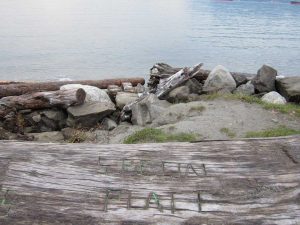
“Special Place” carved into a driftwood log at Locarno Beach in Vancouver
To understand better how we relate to the world around us. Place is a subject of intellectual curiosity because all of us live in places that are distinctive in some way, our language is infused with mentions of place, and our memories are filled with recollections of places. It is well worth considering how place influences our lives, our thinking and our very existence.
-
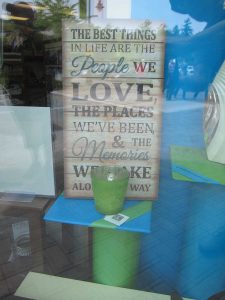 To enable us (those who are interested? everybody?) to enhance our appreciation and enjoyment of the places we experience in everyday life or through travel. And to do this especially by clarifying and communicating the character of place experience and the diverse identities of places. This sign was in a store window in Victoria, British Columbia.
To enable us (those who are interested? everybody?) to enhance our appreciation and enjoyment of the places we experience in everyday life or through travel. And to do this especially by clarifying and communicating the character of place experience and the diverse identities of places. This sign was in a store window in Victoria, British Columbia.
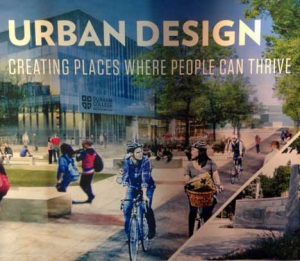 This normative motive is particularly associated with the assumption that place is primarily an aspect of the material world. It has many specific versions. It might involve designing built-environments that aim to improve place and place experiences. It might involve finding ways to live more compatibly with natural environments by identifying the ways that place gathers a continuum of nature-body-mind-society. It might involve finding ways to protect or recover heritage and the qualities of inherited places. It might involve identifying ways for communities to become more resilient in the face of social, economic and environmental changes.
This normative motive is particularly associated with the assumption that place is primarily an aspect of the material world. It has many specific versions. It might involve designing built-environments that aim to improve place and place experiences. It might involve finding ways to live more compatibly with natural environments by identifying the ways that place gathers a continuum of nature-body-mind-society. It might involve finding ways to protect or recover heritage and the qualities of inherited places. It might involve identifying ways for communities to become more resilient in the face of social, economic and environmental changes.
 To improve understanding of community and social relationships to place. An aspect of this is suggested by the posted in Borough Market in London in 2012. An especially important aspect of it has to with understanding and appreciating the grief of displaced communities experiencing rootshock, and for communities in which there is some sense that a distinctive place identity is being eroded by social, economic and/or technological processes, or more specifically by new developments, that fail to respect distinctiveness.
To improve understanding of community and social relationships to place. An aspect of this is suggested by the posted in Borough Market in London in 2012. An especially important aspect of it has to with understanding and appreciating the grief of displaced communities experiencing rootshock, and for communities in which there is some sense that a distinctive place identity is being eroded by social, economic and/or technological processes, or more specifically by new developments, that fail to respect distinctiveness.
- To explain how economic processes flow through and coalesce in places that serve as nodes in those flows, and to explain how different place nodes relate to one another and may exacerbate class differences, social and environmental inequities, uneven development, and injustice. Also to argue for ways to reduce these place injustices. This is, I think, a major reason for those who adopt an economic and relational view of place.
 To propose ways to enhance the benefits of economic flows and processes for particular places by branding and otherwise managing their identities as a way to give them a competitive advantage. Many universities, such as the University of Otago in this advertisement that was on the back of a bus in Wellington, have adopted place branding in order to boost recruitment.
To propose ways to enhance the benefits of economic flows and processes for particular places by branding and otherwise managing their identities as a way to give them a competitive advantage. Many universities, such as the University of Otago in this advertisement that was on the back of a bus in Wellington, have adopted place branding in order to boost recruitment.
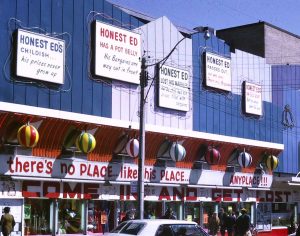 To clarify what is happening in the world by investigating the interplay of processes and manifestations of placelessness (or non-place) and place. Everywhere is simultaneously different from and similar to places elsewhere (as is suggested in the claim that “There’s no place like this place, anyplace” on Honest Ed’s, a low end department store in Toronto that closed down in 2016), but the character of the balance is infinitely varied. The ways in which this balance is shifting because of increased mobility and electronic communications has become especially important because fundamental place ideas about roots, belonging, and locality are being modified by translocal ways of life and significant engagement with many places.
To clarify what is happening in the world by investigating the interplay of processes and manifestations of placelessness (or non-place) and place. Everywhere is simultaneously different from and similar to places elsewhere (as is suggested in the claim that “There’s no place like this place, anyplace” on Honest Ed’s, a low end department store in Toronto that closed down in 2016), but the character of the balance is infinitely varied. The ways in which this balance is shifting because of increased mobility and electronic communications has become especially important because fundamental place ideas about roots, belonging, and locality are being modified by translocal ways of life and significant engagement with many places.
- To seek reality and truth by disclosing the experience of place and the qualities of places. I am not sure that this has been explicitly stated by anyone writing about place, but I can think of no better reason for studying place. I suspect that in some way it is implicated in many of the reasons people have for investigating place. It is consistent with the phenomenological method of returning to the things themselves, with scientific wonder and observation, and with with Goethe called “seeing with clear, fresh eyes.” It is by no means easy because received opinions and contrived theories will inevitably try to intrude, and there are temptations to become selective or exclusionary. But if we choose to attend to them thoughtfully and carefully, our experiences of places are ours alone. They are, at their foundation, what we know of the world for ourselves. In Walden (in the chapter “What I Lived For”) Thoreau captured clearly what this involves and means: “Let us settle ourselves,” he wrote, “and work and wedge our feet down through the mud and slush of opinion, and prejudice…till we come to a hard bottom and rocks in a place, which we can call reality.”